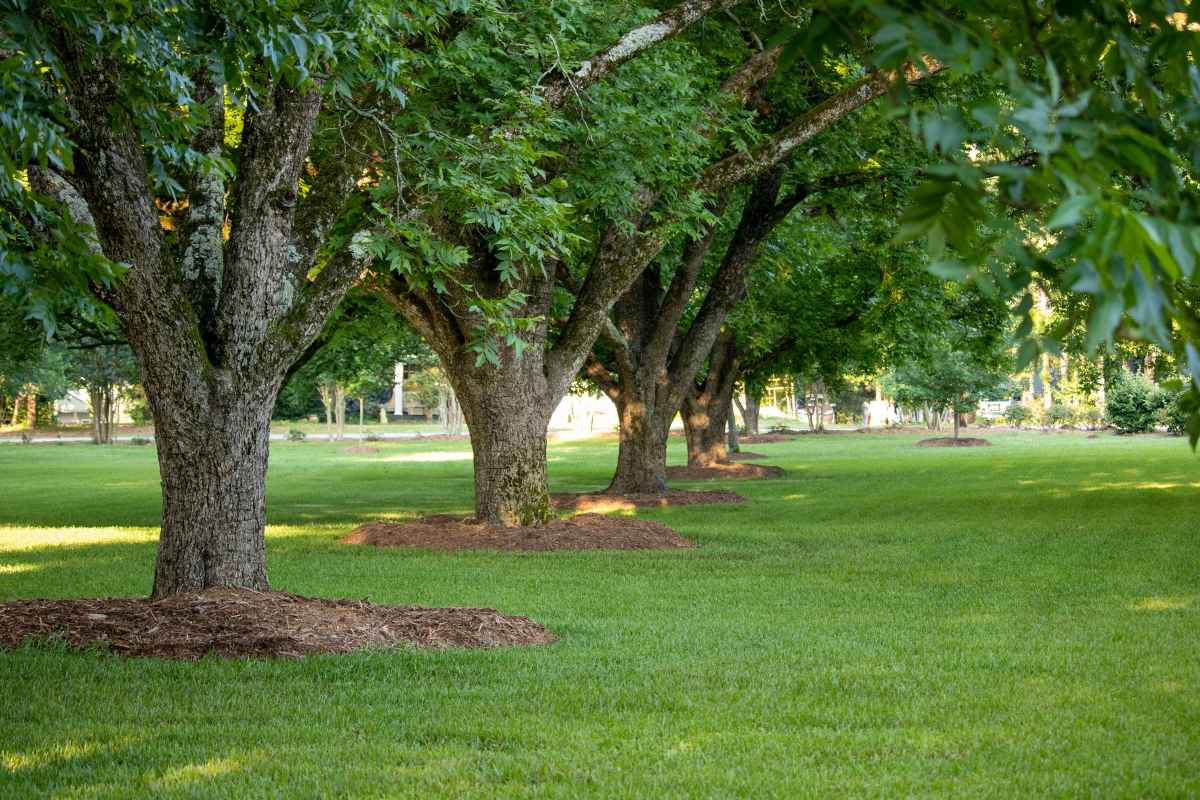
Mulch does wonders for your trees, from conserving moisture to improving soil health — but used incorrectly, it can do more harm than good. Volcano mulching, over-mulching, or burying the root flare can all threaten a tree’s life.
As a longtime landscape designer, I’ll show you how to mulch around your trees the right way — as I did for my clients — and share pro tips on topics like choosing triple-shredded mulch versus wood chips, and what to do if the root flare is buried.
| Project difficulty: Beginner Estimated time to complete: Approximately 2 hours per tree (with a 3-foot mulch circle, and the root flare already visible) Project cost: The cost of mulch can vary based on its type, your location, and how much you purchase. Typically, you can expect to pay $3.25 to $6.50 per bag for a DIY job, or from $77 to $94 per cubic yard professionally installed. |
Step-by-Step Guide for Mulching Around Trees
Mulching does more than make your landscape look neat — it also supports your tree’s health. This step-by-step guide will walk you through the process, enabling you to protect and nourish your trees without causing harm.
Use the 3-3-3 Rule
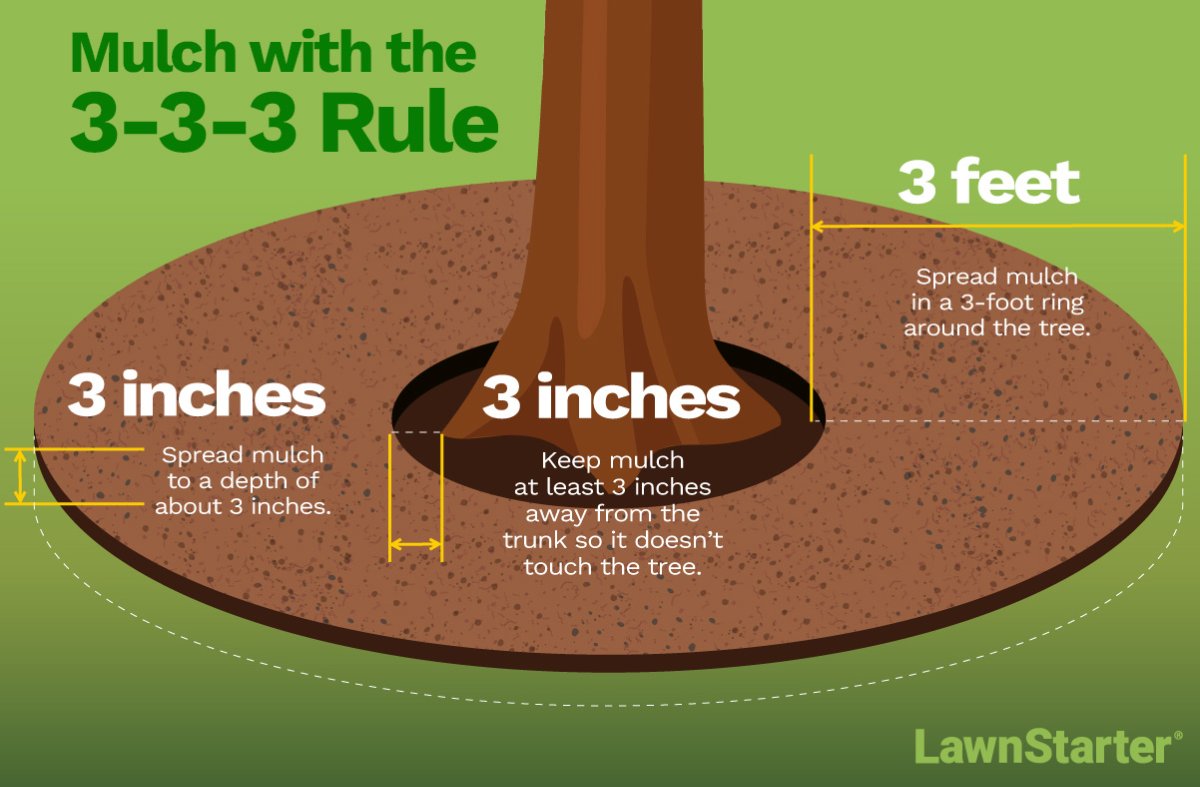
Before you start digging, it helps to plan how you’ll apply mulch around your trees. Ideally, mulch would extend all the way to the tree’s drip line, but in most yards that’s not practical. That’s where the industry-standard 3-3-3 Rule comes in:
- 3 inches deep: Spread mulch to a depth of about 3 inches.
- 3-foot radius: Create a ring of mulch extending roughly 3 feet from the tree trunk.
- 3-inch space: Keep mulch at least 3 inches away from the trunk so it doesn’t touch the tree.
Pro Tip: Need to know how much mulch to buy? Use our mulch calculator. Following the 3-3-3 Rule makes it easy to measure and estimate precisely what you need. If you’d rather leave the math to someone else, hire a LawnStarter landscaping professional to get the job done on time and on budget.
Tools and Materials
- Mulch
- Wheelbarrow
- Measuring tape
- Sod cutter or spade/shovel
- Rake
- Hand trowel (digging for root flare)
- Tie-down strap or string
Step 1: Select the Proper Type of Mulch

With so many types of mulch and colors available, choosing the right one can feel overwhelming. According to Kansas State University Extension, organic wood chips are the best choice for trees since they resist pests and diseases while offering benefits that inorganic mulch — like rubber or stones — does not.
Organic mulch choices:
- Shredded bark or hardwood: Smooth and retains moisture well, but compacts and breaks down faster, requiring frequent top-ups.
- Wood chips: Chunky, airy, and long-lasting, though they retain less moisture. Their rustic look suits informal or woodland-style landscapes.
- Cedar mulch: Durable, slow to decompose, pleasantly scented, and mildly insect-repelling. Great for low-maintenance or drier areas, though pricier.
Pro Tip: My clients favored triple-ground hardwood mulch for its polished look and moisture retention, but it breaks down faster. Wood chips are chunkier, aerate better, last longer, and give a natural, low-maintenance appearance.
See Related:
Step 2: Edge Around the Tree
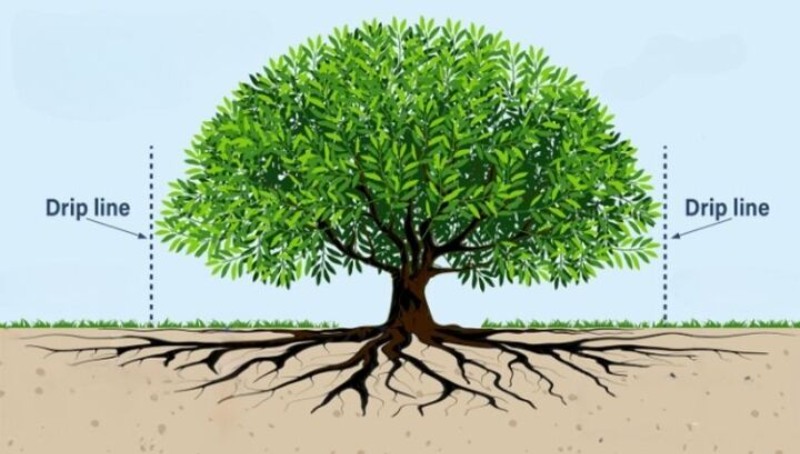
Creating an edge around your tree is easy. Mulch circles should typically extend 3 feet in diameter (most common for residential yards) or to the tree’s drip line, whichever is feasible in your yard.
For a precise 3-foot circle, use a tie-down strap or string to form a tight loop around the tree’s base. Place a manual edger inside this loop and begin edging, using the strap to maintain a consistent 3-foot distance from the trunk.
Step 3: Remove Grass/Sod and Level the Ground
Now that you’ve created an edge around the tree, you can see where the grass needs to be removed. Here’s how to remove the grass and tidy the area before laying down the mulch:
- Remove the existing grass with a sod cutter or a spade shovel within the mulch circle you created.
- Hand-pull any weeds that you see, as weeds near the root flare compete for water and nutrients.
- Put down pre-emergent herbicide on the bare soil.
- Rake to mix in the pre-emergent and smooth out the soil.
Step 4: Install a Mulch Barrier (Garden Edging)
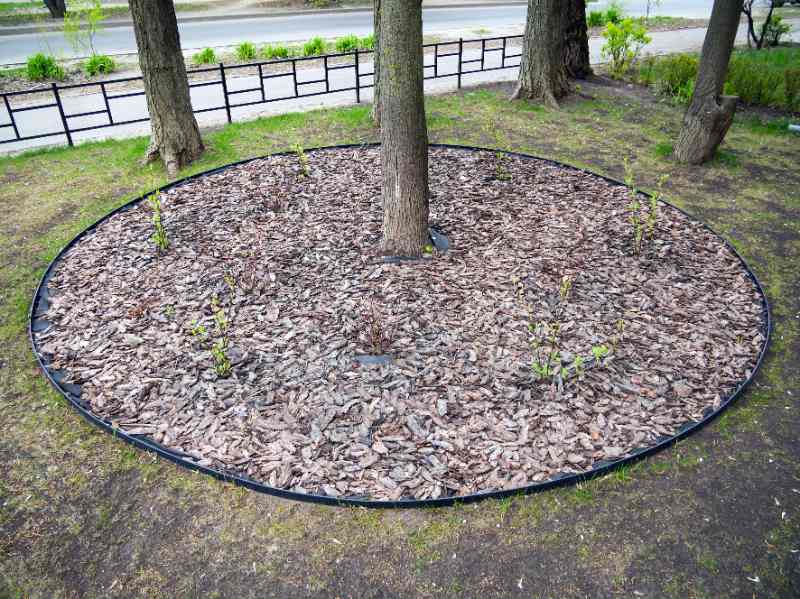
At this point, you’ve created an edge, removed the existing grass and weeds, and leveled the soil. Now’s the time to install a mulch barrier with garden edging to keep the mulch contained and create an edge that delineates the lawn from the mulch ring.
No-Dig Edging: Best Budget Option
No-dig edging is a great choice if you’re on a budget, want a quick weekend project, or need a temporary solution that’s easy to replace or adjust. It’s affordable, lightweight, and simple to install.
This edging comes in a flexible roll with pre-drilled holes, connectors, and spikes — you simply shape it around the tree circle, trim if needed, and join the ends. Once in place, hammer the spikes through the holes to secure the border, then backfill inside the circle with mulch or soil for a clean finish.
In-Ground Edging: Best for Longevity
While no-dig edging has its place, I favor cobblestones or other in-ground options (pavers, bricks) as a long-term solution. They’re durable, resist mower damage, withstand harsh winters, and bring a timeless, elegant look to any landscape.
To install in-ground edging, dig a shallow trench sized for your stones and their placement (horizontal or vertical). Add a compacted gravel or sand base, set the stones snugly side by side, and backfill to create a sturdy, long-lasting edge.
See Related: How to Keep Mulch in Place
Step 5: Check for and Expose the Root Flare
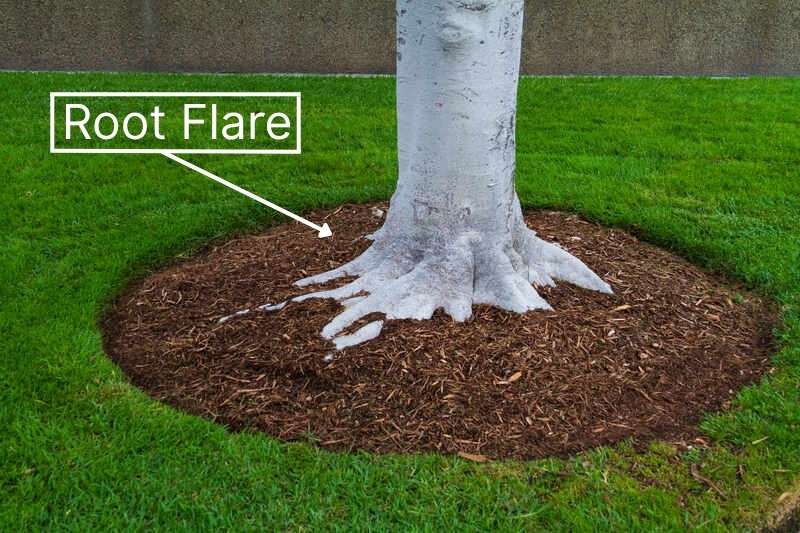
When inspecting a tree for its root flare, you’ll encounter one of two situations:
- Exposed root flare (ideal): You can see where the trunk widens at the base and meets the primary roots.
- Buried root flare (less ideal): You’ll see the trunk, but there are no visible roots. If the roots aren’t buried too deeply, carefully dig around them with a hand trowel, clearing away soil or debris until the trunk visibly widens into the roots.
Note: For larger or more difficult excavations, it’s best to call a certified arborist. They have specialized tools, including an Air Spade, that can safely expose deeper roots without damaging the tree.
Step 6: Apply Mulch in a “Donut” Shape
Once you’ve exposed the root flare, spread mulch in an even ring about 3 inches deep, extending roughly 3 feet from the base. Leave a mulch-free circle at least 3 inches wide around the trunk to prevent rot and pests.
Common Mistakes for Mulching Around Trees
If you follow the 3-3-3 Rule and my tips above, you’ll be on your way to a healthy, attractively mulched tree. But here are 3 common mistakes you’ve probably seen in your neighborhood and why it’s best to avoid them.
Volcano Mulching
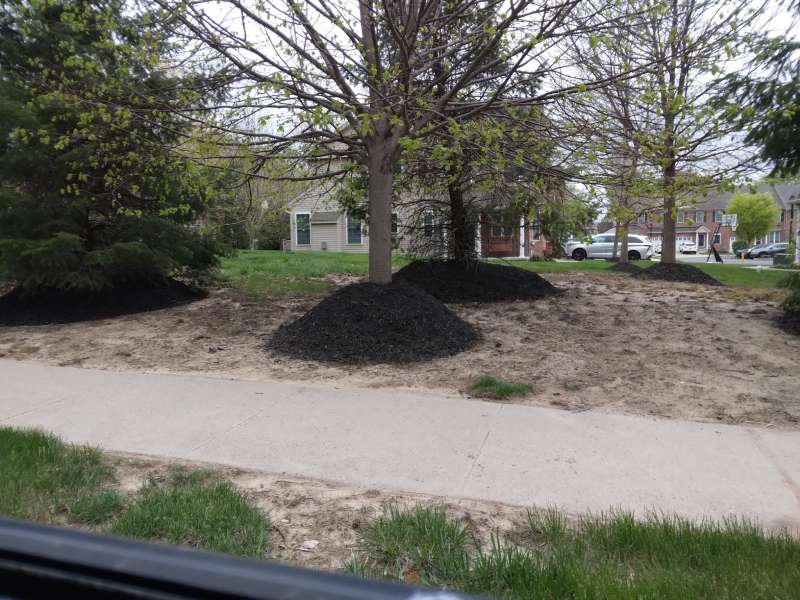
Volcano mulching is the harmful practice of piling mulch in a volcano shape against a tree trunk. Though often done to reduce weeds or improve appearance, it suffocates bark, encourages rot, and attracts pests.
Over-Mulching
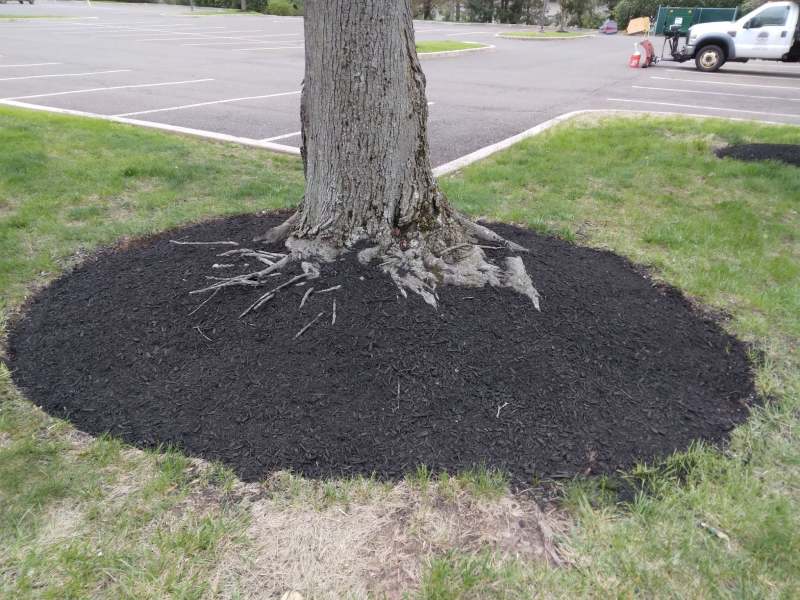
Over-mulching is applying more than 2-4 inches, depending on the tree. This suffocates roots, blocks nutrients, and invites rot, disease, and pests. Covering the root flare can also cause girdling roots that slowly strangle the tree.
Stone Mulching
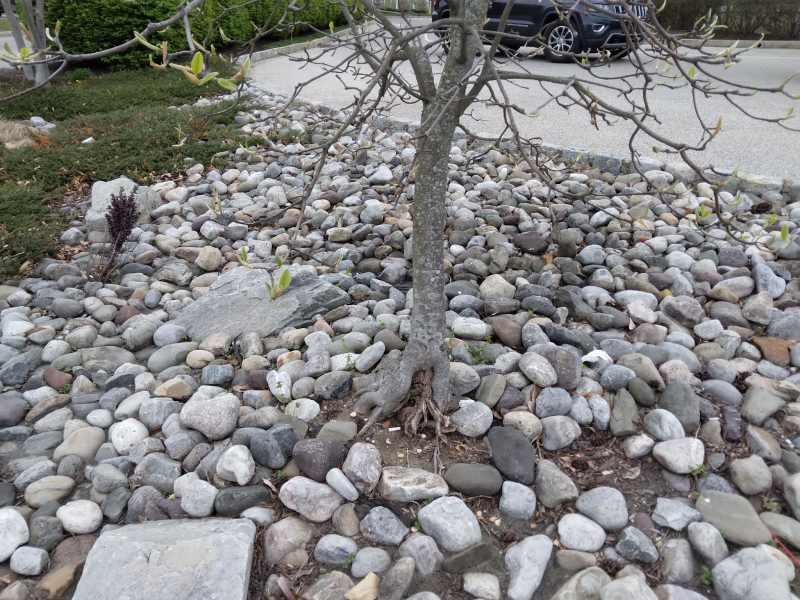
Using stones instead of organic mulch can be harmful to trees. The stones trap heat, dry out soil (which then requires more watering), and add no nutrients. They also shift easily and can damage lawnmowers.
FAQ
While many homeowners still use landscape fabric around trees, the landscaping industry generally advises against it, believing it does more harm than good. Check out our article to discover the pros and cons of using landscape fabric.
Exposed roots? No problem. Just spread a layer of mulch over them — no more than 3 inches deep — to protect the roots while keeping your tree happy and healthy.
Not really — trees generally benefit from mulch as long as it’s applied correctly.
Mulch Smarter, Not Harder, by Calling a Pro
If spreading mulch around your trees feels like a chore, you’re not alone. Hiring a local LawnStarter landscaping expert can save time, reduce effort, and let you enjoy your weekend while keeping your trees healthy and your yard looking great.
Sources:
- “How to Mulch the Trees the Right Way.” K-State Research and Extension Johnson County.
- “Mulch the Right Way.” North Carolina Urban Forest Council.
- “Volcanoes Killing Trees in New Jersey.” NJ DEP Division of Parks and Forestry.
- “Proper Mulching Techniques.” Forestry Division of the Department of Public Works, Oak Creek, WI.
- “Show Me Your Root Flare!” By Ellen A. Vincent, environmental landscape specialist. Clemson University Horticulture Dept.
- “The Secret to Tree and Shrub Health.” Smithsonian Gardens.
Main Image: A row of mulched pecan trees in a park. Image Credit: Jen Wolf / Adobe Stock